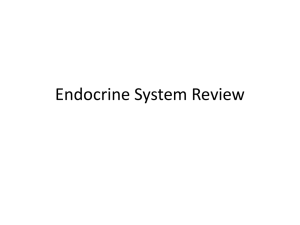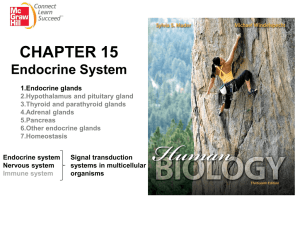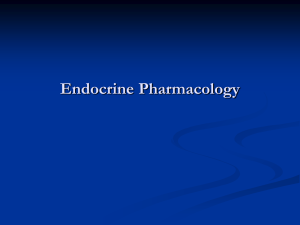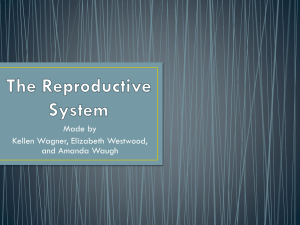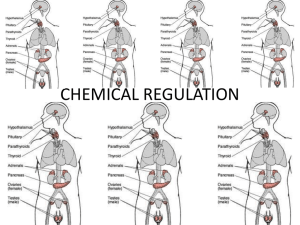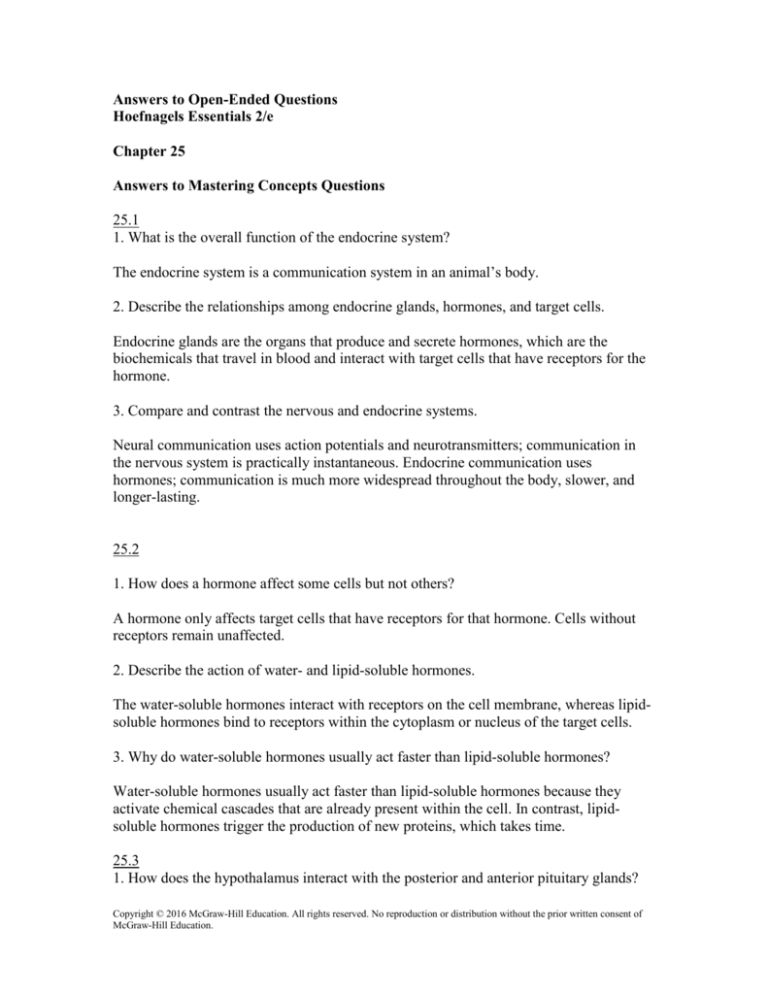
Answers to Open-Ended Questions
Hoefnagels Essentials 2/e
Chapter 25
Answers to Mastering Concepts Questions
25.1
1. What is the overall function of the endocrine system?
The endocrine system is a communication system in an animal’s body.
2. Describe the relationships among endocrine glands, hormones, and target cells.
Endocrine glands are the organs that produce and secrete hormones, which are the
biochemicals that travel in blood and interact with target cells that have receptors for the
hormone.
3. Compare and contrast the nervous and endocrine systems.
Neural communication uses action potentials and neurotransmitters; communication in
the nervous system is practically instantaneous. Endocrine communication uses
hormones; communication is much more widespread throughout the body, slower, and
longer-lasting.
25.2
1. How does a hormone affect some cells but not others?
A hormone only affects target cells that have receptors for that hormone. Cells without
receptors remain unaffected.
2. Describe the action of water- and lipid-soluble hormones.
The water-soluble hormones interact with receptors on the cell membrane, whereas lipidsoluble hormones bind to receptors within the cytoplasm or nucleus of the target cells.
3. Why do water-soluble hormones usually act faster than lipid-soluble hormones?
Water-soluble hormones usually act faster than lipid-soluble hormones because they
activate chemical cascades that are already present within the cell. In contrast, lipidsoluble hormones trigger the production of new proteins, which takes time.
25.3
1. How does the hypothalamus interact with the posterior and anterior pituitary glands?
Copyright © 2016 McGraw-Hill Education. All rights reserved. No reproduction or distribution without the prior written consent of
McGraw-Hill Education.
The hypothalamus produces “releasing hormones” and “inhibiting hormones” that
stimulate or inhibit the secretion of other hormones from the anterior pituitary. In
addition, the hypothalamus secretes two hormones that are stored and released by the
posterior pituitary.
2. List the names and functions of the hormones released by the posterior and anterior
pituitary glands.
The posterior pituitary releases oxytocin, which stimulates smooth muscle contraction in
the uterus and mammary glands. The posterior pituitary also releases ADH, which
promotes water conservation in the kidneys. The anterior pituitary secretes GH to
stimulate tissue growth, prolactin to stimulate milk production, TSH to stimulate the
secretion of thyroid hormones, ACTH to stimulate the secretion of glucocorticoid
hormones from the adrenal cortex, FSH and LH to stimulate sex cell production and sex
hormone secretion, and endorphins to relieve pain.
25.4
1. Describe the functions of each of the thyroid’s hormones.
The three thyroid hormones are thyroxine (increases the rate of metabolism in cells),
triiodothyronine (increases the rate of metabolism in cells); and calcitonin (increases the
rate at which calcium is deposited in bone).
2. What is the function of parathyroid hormone (PTH)?
PTH increases calcium levels in blood and tissue fluid by increasing calcium release from
bones, and by increasing calcium absorption into the blood from the digestive tract and
kidneys.
3. Compare the hormones of the adrenal cortex and medulla.
Hormones secreted by the adrenal cortex (glucocorticoids and mineralocorticoids)
suppress the immune system, are important in the body’s response to prolonged stress,
and maintain blood volume and salt balance. Hormones secreted by the adrenal medulla
(epinephrine and norepinephrine) are important in the body’s response to short-term
stress. They increase the heart rate, blood pressure, breathing rate, and metabolic rate.
4. Describe the opposing roles of insulin and glucagon.
Insulin removes glucose from the bloodstream by stimulating cells to absorb it. Glucagon
stimulates liver cells to release glucose into the bloodstream.
5. How do darkness and light affect melatonin secretion?
Copyright © 2016 McGraw-Hill Education. All rights reserved. No reproduction or distribution without the prior written consent of
McGraw-Hill Education.
Darkness stimulates melatonin production, whereas light inhibits melatonin synthesis in
the pineal gland.
25.5
1. Which organs contain target cells for FSH and LH?
The cells of the testes and the ovaries contain receptors for FSH and LH.
2. What are the functions of estrogen, progesterone, and testosterone?
Estrogen helps regulate the menstrual cycle and promotes the development of female
secondary sex characteristics. Progesterone helps regulate the menstrual cycle and
prepares the female body for a pregnancy. Testosterone promotes sperm development and
maintains male secondary sex characteristics.
Write It Out
1. How does the endocrine system interact with the circulatory system?
The endocrine system interacts with the circulatory system by releasing hormones into
the bloodstream, which carries the hormones throughout the body.
2. Write a paragraph describing the events that occur from the time an endocrine gland
releases a steroid hormone to the time the hormone exerts its effects on a target cell.
An endocrine gland releases a steroid hormone into the bloodstream. It travels throughout
the circulatory system and then passes through the cell membrane of a target cell
(although the hormone does not “know” to travel directly to the target cell). The hormone
binds to a receptor protein within the cytoplasm or nucleus of the cell. The receptor
protein then changes the expression of genes, leading to the production of proteins that
carry out the target cell’s response.
3. What prevents a hormone from affecting all body cells equally?
A hormone exerts a physiological effect only on target cells that have specific receptors
for the hormone.
4. Describe an example of negative feedback on a hormone released from the anterior
pituitary.
If the thyroid hormone concentration is too low, the hypothalamus produces more
thyroid-releasing hormone (TRH). In response, the anterior pituitary increases its
secretion of thyroid-stimulating hormone (TSH), which stimulates an increase in the
secretion of thyroid hormones. On the other hand, a high level of thyroid hormone
decreases the release of TRH from the hypothalamus. The anterior pituitary, in turn,
secretes less TSH, and the thyroid hormone concentration drops.
Copyright © 2016 McGraw-Hill Education. All rights reserved. No reproduction or distribution without the prior written consent of
McGraw-Hill Education.
5. Sketch the mechanisms of water-soluble and lipid-soluble hormone function.
[Answer will be visual. Refer to figure 25.2.]
6. List the hormones released from the posterior pituitary and the anterior pituitary.
The posterior pituitary releases antidiuretic hormone (ADH) and oxytocin. The anterior
pituitary gland releases growth hormone, prolactin, follicle-stimulating hormone (FSH),
luteinizing hormone (LH), thyroid-stimulating hormone (TSH), adrenocorticotropic
hormone (ACTH), and endorphins.
7. Give two examples of hormones counteracting the effects of one another.
[Answers will vary; here are two examples.] Calcitonin increases the rate of calcium
deposition in bone, whereas parathyroid hormone releases calcium from bone. Insulin
decreases blood glucose level, whereas glucagon increases blood glucose level.
8. Which hormone(s) match each of the following descriptions?
a. Produced by a woman who is breast feeding
b. Causes fatigue if too little is present
c. Causes increase in blood calcium level
d. Causes decrease in blood glucose level
e. Synthetic steroids mimic the muscle-building effects of this hormone
(a) Prolactin; (b) insulin and thyroxine (metabolic rate declines if too little is present); (c)
parathyroid hormone (PTH); (d) insulin; (e) testosterone
9. Alcohol and caffeine inhibit the effects of antidiuretic hormone. Explain why drinking
beer or coffee increases the frequency of urination.
Normally, ADH increases the reabsorption of water in the kidneys, keeping blood volume
high and making urine concentrated. When ADH function is inhibited, the blood loses
water, and the body produces copious amount of dilute urine.
10. Some major league baseball players use human growth hormone (a banned substance)
to aid in fast recovery after difficult workouts. How would GH help speed a player’s
recovery? Is GH use the same as anabolic steroid use?
Growth hormone (GH) increases the rates of protein synthesis and cell division. Difficult
workouts damage muscle, bone, and cartilage. Increasing the rates of protein synthesis
and cell division therefore speeds up recovery. GH is not an anabolic steroid (which
mimics testosterone); however, both GH and anabolic steroids may help athletes gain
muscle mass.
Copyright © 2016 McGraw-Hill Education. All rights reserved. No reproduction or distribution without the prior written consent of
McGraw-Hill Education.
11. Why can a stressful lifestyle lead to heart attacks? Which hormone is released in
response to long-term stress?
A body under long-term stress has high levels of glucocorticoids, such as cortisol. Stress
hormones constrict blood vessels and decrease immune response, both of which prepare
the body to handle stress. These hormones are therefore beneficial when infrequently
released. However, chronically high levels of glucocorticoids maintain narrowed blood
vessels, which strains the cardiovascular system and can lead to heart attacks. (For more
on how long-term stress affects health, see this chapter’s Burning Question.)
12. Would an insulin injection help a person with type 2 diabetes? Why or why not?
In type 2 diabetes, the body cells fail to absorb glucose even when insulin is present.
Therefore, injecting additional insulin will not help.
13. Identify the target cells and effects of FSH, LH, estrogen, progesterone, and
testosterone.
FSH affects target cells in the ovaries and testes, stimulating gamete production. LH
stimulates target cells in the ovaries and testes to produce sex hormones. Estrogen affects
target cells in the uterus and brain, regulating the menstrual cycle and the development of
female secondary sex characteristics. Progesterone affects target cells in the uterus and
brain, regulating the menstrual cycle and preparing the body for pregnancy. Testosterone
affects target cells in the embryo to stimulate male development; the same hormone also
affects target cells throughout the body, stimulating sperm production and maintaining
male secondary sex characteristics.
14. An endocrine disruptor is a molecule that either mimics or blocks the activity of a
hormone. Propose a way to test the hypothesis that microwaving foods in plastic
containers releases endocrine disruptors.
Answers will vary, but the experiment should include one or more treatment group (foods
microwaved in plastic containers), a control group (foods stored but not microwaved in
plastic containers), standardized variables (same types of foods and plastic containers,
same duration, etc.), and an objective way to measure whether endocrine disruptors were
released from the plastic.
Pull It Together
1. Describe a negative feedback loop that controls hormone secretion.
[Multiple answers are possible; this is one example]. If cells in the hypothalamus detect
that the body’s fluids are too concentrated, the posterior pituitary releases more ADH.
This hormone stimulates kidney cells to return water to the blood, and the body’s fluids
become more dilute. Once balance is restored, ADH production slows.
Copyright © 2016 McGraw-Hill Education. All rights reserved. No reproduction or distribution without the prior written consent of
McGraw-Hill Education.
2. Connect each hormone discussed in this chapter to the gland that produces it and to
either the “Water-soluble” or “Lipid-soluble” box.
Consult figures 25.4, 25.6, 25.8, and 25.12 to check your answers.
3. Label the endocrine glands that are primarily regulated by signals from the nervous
system; by hormones from the hypothalamus; by hormones from the anterior pituitary;
and by the concentration of calcium or sugar in the blood.
Signals from the nervous system: Hypothalamus, adrenal glands (medulla). Hormones
from the hypothalamus: Pituitary gland. Hormones from the anterior pituitary: Thyroid
gland, adrenal glands (cortex), ovaries, testes. Concentration of calcium or sugar in the
blood: parathyroid glands (calcium), pancreas (sugar).
Copyright © 2016 McGraw-Hill Education. All rights reserved. No reproduction or distribution without the prior written consent of
McGraw-Hill Education.



